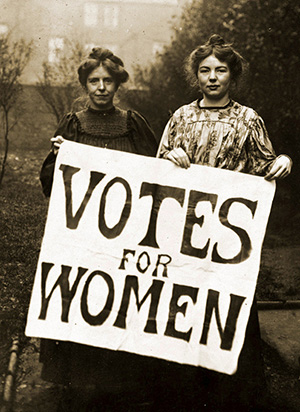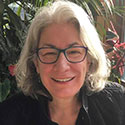Continuing Efforts Toward Full Equality

As a child of the 1960s, plus a few years on either side of that decade, I was only exposed to American history in school that supported the supremacy of white men of European descent—the conquerors, explorers, colonists, founders, inventors, presidents, and other men favored by historians of yore.
I remember passing reference to the “suffragettes” who marched in the early 1900s to gain women the right to vote. Years later, I learned about agitation, imprisonment, hunger strikes, and assaults on their bodies and characters. That wasn’t mentioned in the history books I was assigned to read in school.

Annie Kenney and Christabel Pankhurst were two of many women who fought for the right to vote in the early 1900s.
The 19th amendment to the constitution was passed by Congress in June 1919 and ratified on August 18, 1920—granting women the right to vote. That was 102 years ago.
Fast forward to 1971: Bella Abzug, a member of Congress from New York, launched an effort to declare August 18 as “Women’s Equality Day.” Made official in 1973, the date commemorates the 1920 certification of the 19th Amendment to the Constitution and calls attention to women’s continuing efforts toward full equality.
After all these years, we are still fighting for full equality—the right to vote without intimidation or other barriers, the right to make our own reproductive choices, the right to equal pay for equal work, the expectation of full respect by elected officials and other leaders, regardless of gender, sexual orientation, race, age, ability, economic assets, country of origin, and more.
In 2017, I had the opportunity to work with some awesome women in planning and presenting Age Friendly Seattle’s “Engaging Aging: Seattle Women’s Equity Forum.” Video from the forum is available on the Seattle Channel (click here). The topics addressed are still valid today—economic security; physical, mental, and environmental health and longevity; caregiving responsibilities; gender-based violence; and the need for empowerment of girls and women.
Recently I watched and listened again to LueRachelle Brim-Atkins’ keynote presentation, “The Triple Whammy: Ageism, Racism & Sexism” (16:09–29:55 on the video linked above) and am so glad that the forum opened with acknowledgement of the intersections of age, gender, and race, and the “isms” that accompany them. I encourage you to watch.
I am a white cisgender woman who is increasingly aware of the ways in which gender-based discrimination intersects with race, age, sexual orientation, and more. As a woman, I have experienced discrimination; yet I know with certainty that women of color and people who identify with additional forms of diversity have experienced far greater discrimination throughout their lives than I will ever know. My challenge is to recognize privilege that I hold while remaining humble, knowing that my privilege is unearned.
As Ijeoma Oluo, the Seattle-based author of So You Want to Talk About Race (available through the public library), said, “Intersectionality and the recognition and confrontation of our privilege can make us better people with better lives.”
In June, I had the opportunity to hear author Dr. Ibram X. Kendi speak at Town Hall Seattle. Dr. Kendi has written many books, most recently focused on raising an antiracist child. Several years ago, he wrote “How to Be an Antiracist,” in which he said, “The opposite of racist isn’t ‘not racist.’ It is ‘anti-racist.’” That’s something to discuss with family, friends, and colleagues.
I guess what it comes down to, for me, is a strong belief in equity and justice for all. And yet, where we have a chance to make a difference by highlighting and discussing inequities and helping people understand lives that may be very different from their own—for example, highlighting gender inequality on Women’s Equality Day, LGBTQIA+ inequalities during Pride Month (June), ageism and ableism during Older Americans Month (May), racial disparities during Black History Month (February), and countless other occasions—we should do it.
You’ve probably heard the saying that “love isn’t pie—an extra slice for you doesn’t mean less for me,” or some variation of that. I think showing respect for others is the same. Speaking out on behalf any one group of disenfranchised people doesn’t mean there’s less respect for others—rather, by highlighting inequities, we can build empathy, compassion, and understanding of lived experiences, and converse rationally about strategies that will reduce disparities. I think that’s what it means to support equality for all.
 Contributor Irene Stewart manages communications for the Seattle Human Services Department and is editor of AgeWise King County.
Contributor Irene Stewart manages communications for the Seattle Human Services Department and is editor of AgeWise King County.
This article and the resource list below originally appeared in the August 2022 issue of AgeWise King County.
Women in History Resources
- ‘Gender equality pioneers’: Influential women from Washington includes state and Seattle politicians (USA Today)
- 9 Women From American History You Should Know, According to Historians (Time)
- Seattle Women’s History Timeline (Seattle Municipal Archives)
- The 30 Women Who Shaped Seattle (Seattle Met Magazine)
- Women and Seattle’s Civil Rights History (Seattle Civil Rights and Labor History Project)
- Women in Labor History (Zinn Education Project)
- Women in the Labor Movement (National Park Service)
- Women Who Shaped History (Smithsonian Magazine)
![Aging & Disability Services for Seattle & King County [logo]](https://www.agingkingcounty.org/wp-content/themes/sads/images/seattle-ads-logo.png)